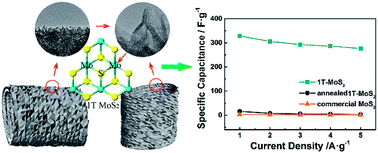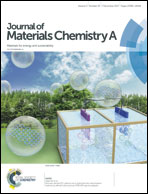Hierarchical 1T-MoS2 nanotubular structures for enhanced supercapacitive performance†
Abstract
Layered transition metal disulfides are currently being widely studied for advanced energy generation and storage applications. Here we report a facile template-assisted solvothermal strategy to obtain a hierarchical nanotubular structure consisting of ultrathin MoS2 nanosheets with a metallic 1T phase. Synchrotron radiation based X-ray absorption fine structure (XAFS) and X-ray photoelectron spectroscopy (XPS) are used to investigate the structure and electronic properties of the 1T-MoS2, which are largely different from annealed samples. Its hierarchical structure makes the obtained nanotubular 1T-MoS2 an excellent electrode material for supercapacitors, with a high specific capacitance of 328.547 F g−1 at a current density of 1 A g−1 and 243.66 F g−1 at a current density of 15 A g−1. Moreover, the material displays excellent capacitance retention, retaining 98.4% capacity after 5000 cycles at a current density of 3 A g−1. Notably, a high specific capacitance of 250 F g−1 at 1 A g−1 is also achieved in a two-electrode symmetrical cell, suggesting its great potential for new-generation supercapacitors.



 Please wait while we load your content...
Please wait while we load your content...